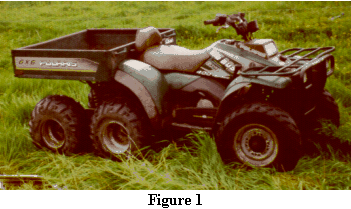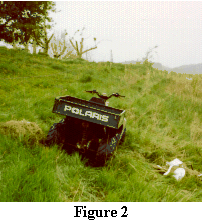Beef Farmer Pinned Under Overturned All-Terrain Vehicle in Wisconsin
FACE 00WI03901

SUMMARY:
A 50-year-old male farmer (the victim) died when he was trapped under a six-wheel all-terrain vehicle (ATV) that overturned on a hillside where he was repairing fences. The vehicle was equipped with a raised cargo box where he carried his tools and supplies (Figure 1). The vehicle apparently struck a small hay bale that was partially hidden in the grass on the uphill side, and rolled over sideways down the hill. The victim either jumped or was tossed from the vehicle as it overturned, and was pinned underneath. ATV’s, including this model, are not equipped with ROPS or a seatbelt. When the victim did not return to the farmhouse for dinner as expected, his family searched the farm area but did not locate him. He frequently helped neighbor farmers with their work, so the family assumed he might be involved in a task off the farm and stopped searching for him. When he didn’t return the next morning, they resumed their search and found him beneath the vehicle. Emergency services were summoned, and were onsite within six minutes. The coroner pronounced the victim dead at the scene. DNR conservation wardens were also summoned to determine if state all-terrain-vehicle (ATV) requirements applied to the incident. The FACE investigator concluded that, to prevent similar occurrences, farmers and other employers who use off-road utility vehicles should:
- select a non-ATV utility vehicle with ROPS and designed to maintain a low center of gravity.
- conduct a thorough evaluation of the terrain to identify hazards in the pathway prior to beginning an operation with an off-road vehicle.
INTRODUCTION:
On May 8, 2000, a 50-year-old male beef farmer died when the six-wheel ATV he was operating overturned on a hillside. The Wisconsin FACE field investigator learned of the incident through the newspaper on May 9, 2000. On July 17, 2000, the field investigator went to the scene and met with the victim’s family. The FACE investigator also obtained the death certificate, the coroner and sheriff’s reports and photos from the DNR conservation warden.
The victim and his family had owned and operated the beef farm where the incident occurred for about 23 years. They had about 50 cattle at the time of the incident, and also maintained hayfields for cattle pasture and harvesting hay as bales. The farm business had no employees outside of the family members. It was customary in this farm neighborhood for farmers to help each other as needed, including sharing equipment and assisting with machine repairs. The victim often helped other farmers, and would be gone from his farm during those times.
The victim had spent his youth on a farm, and learned to operate machinery through on-the-job experience. His lower right leg was missing as a result of an injury he received in the Vietnam conflict, and he wore a prosthesis for walking. The family’s personal vehicle was fitted with adaptive devices which assisted him in driving, in accordance with the auto manufacturer’s specifications. When he needed adaptation of farm equipment or facilities, he and his neighbors would work together to construct something to meet his needs. As an example, one of the farm tractors had been fitted with a low step to assist him in climbing onto the machine. The victim had not been seriously injured on the farm prior to the incident. He had been involved in a tractor rollover incident some years ago, but was not injured.
The Polaris Big Boy 6×6 ATV had been obtained new by the victim about four years before the incident. This vehicle was the second of its type used on the farm; it replaced an earlier model that had burned for an unknown reason. He used it primarily on the farm for transportation and to carry light loads of tools, supplies, and cattle feed. A molded plastic cargo box on the vehicle had a manufacturer’s rated capacity of 800 pounds. The box was located behind the operator’s seat, high over the rear two wheels of the vehicle. It was a six-wheel drive vehicle, with air-filled tires and automatic shifting. Like all ATV’s, this model was not equipped with ROPS or seatbelts. Family members reported that although the ATV was capable of speeds close to 30 mph, they did not drive it at high speeds because of the bumpy ride it produced.
INVESTIGATION:

On the day of the incident, the victim completed his farm chores as usual from morning through mid-afternoon. He rested in the farmhouse, then told his wife he was going to check the fence that divided a grazing pasture. The fence was constructed of metal poles, with a single line of barbed wire intertwined with an electric strand. It was located midway down a hillside that led up to the county road. At this time of year, the grass in the pasture was about 15 inches tall, and partially hid a small haybale that may have been in the field from a previous year (Figure 2). The victim loaded some tools and fence repair supplies into the cargo box of the ATV, and drove along the fenceline on the hillside. At a place on the hill where there is about a 30° grade, the vehicle’s left front tire apparently struck the small haybale on the uphill side and rolled over sideways down the hill.
The victim either jumped or was tossed from the vehicle as it overturned, and was pinned underneath it. When the victim did not return to the farmhouse for dinner as expected, his family searched the farm area but did not locate him. The family assumed he might be involved in a task off the farm, possibly at a neighbor’s farm, and stopped searching for him. When he hadn’t returned early the next morning, they resumed their search and found him lying face-down beneath the overturned vehicle. Emergency services were summoned, and were onsite within six minutes. The coroner pronounced the victim dead at the scene. DNR conservation wardens were also summoned to determine if state ATV requirements applied to the incident. (The vehicle weighed 850 lbs., which exceeds the state’s ATV definition by 150 pounds.)
CAUSE OF DEATH:
The death certificate listed the cause of death as asphyxiation.
Recommendations/Discussion
Recommendation #1: Farmers and other employers who use utility vehicles should select a non-ATV utility vehicle equipped with ROPS and designed to maintain a low center of gravity.
Discussion: In this incident, the victim was operating a six-wheel ATV equipped with a cargo box. The box was mounted high on the back of the vehicle, at the same level as the operator’s seat, so the center of gravity was raised to a point that created a tipping hazard for the vehicle especially when the box was loaded with heavy items. If the vehicle had been fitted with ROPS and a seatbelt, the victim might not have suffered serious injury during a rollover. Employers with a need for off-road transportation and carrying small items should contact manufacturers and dealers to determine model specifications, and choose models that are fitted with ROPS and a seatbelt, and are designed to maintain a low center of gravity when operated with a heavy or bulky load.
Recommendation #2: Farmers should conduct a thorough evaluation of the terrain to identify hazards in the pathway prior to beginning an operation with an off-road vehicle.
Discussion: Off-road vehicle operators have access to terrain that may be laden with unseen hazards. Before driving through uneven, grassy or snow-covered terrain, the operator should view the pathway carefully to ensure that no hidden hazards are present. These could include solid objects, deep holes or fissures, water-filled depressions, biological hazards (e.g. stinging insects), etc. Even if an operator has traveled through the area before, the hazard may not have been present, or the operator’s pathway may change to place him/her in line with an unsafe situation. In this case, the victim had driven the ATV through the pasture before the day of the incident, but may have avoided striking the haybale on those trips.
FATAL ASSESSMENT AND CONTROL EVALUATION (FACE) PROGRAM
FACE 00WI03901
Staff members of the FACE Project of the Wisconsin Division of Health, Bureau of Public Health, do FACE investigations when a work-related fatal machine-related, youth worker or road construction work-zone death is reported. The goal of these investigations is to prevent fatal work injuries in the future by studying: the working environment, the worker, the task the worker was performing, the tools the worker was using, the energy exchange resulting in fatal injury and the role of management in controlling how these factors interact.
To contact Wisconsin State FACE program personnel regarding State-based FACE reports, please use information listed on the Contact Sheet on the NIOSH FACE web site. Please contact In-house FACE program personnel regarding In-house FACE reports and to gain assistance when State-FACE program personnel cannot be reached.
